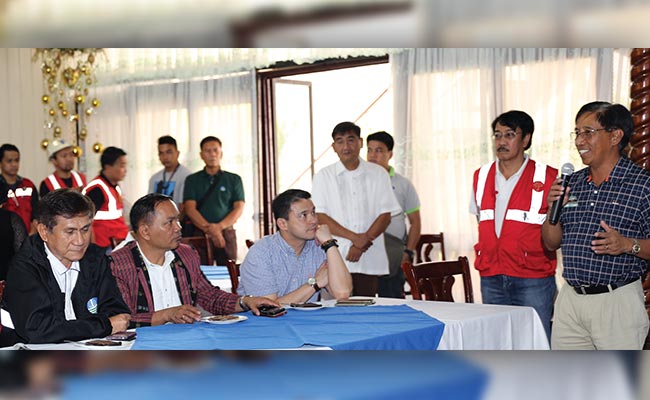
Mine firm assures integrity of storage facility

BAGUIO. Philex Mining Corp. president and CEO Eulalio Austin briefs DENR Secretary Roy Cimatu; DENR-Cordillera regional director Ralph Pablo and DENR Asst. Secretary Juan Miguel Cuna on the integrity of Padcal mine’s TSF3. (Photo by PMC) TUBA, Benguet — Philex Mining Corp. assured Environment Secretary Roy Cimatu on the integrity of its Tailings Storage Facility No. 3 (TSF) at the company’s Padcal mine, as well as the continuation of its programs on environmental protection upon the instruction of the Cabinet official, who came over on Wednesday afternoon.
“We can assure you, Mr. Secretary, that our tailings pond can handle the volume of rainwater more than what the worst typhoons had caused,” Eulalio Austin, Jr., CEO and president of Philex Mining, said during a presentation at the Philex Guest House.
Austin also said the tailings pond could withstand earthquakes equivalent to the strongest that have hit the country.
Cimatu, who arrived July 19 with a 25-man entourage at Padcal mine, the company’s gold-and-copper operations hosted by the Benguet towns of Tuba and Itogon, pressed Austin and other Philex Mining officials on the ability and reliability of TSF3 and its accompanying structures to withstand flooding and earthquake, bearing in mind the 2012 accident following two typhoons.
Philex Mining SVP and Padcal resident manager Manuel Agcaoili said TSF3’s open spillway, which has replaced its underground drainage system since August 2013, was built with embankment-design parameters based on ANCOLD and ICOLD guidelines and could, therefore, handle the amount of rainwater more than what Typhoons Ondoy (2009) as well as Ferdie and Gener (2012) had caused.
The Aussie apolitical industry body ANCOLD, or Australian National Committee on Large Dams, and the ICOLD, or International Commission on Large Dams, a European NGO founded in Paris, provide guidelines in the building of dams that are safe, economical, and environmentally and socially sustainable. These are vital to achieving excellence for all aspects of dam engineering, management, and related issues.
While at TSF 3, in Itogon’s Sitio Balog, Brgy. Ampucao, which is an hour drive from the Padcal mine offices, Cimatu acknowleged the efforts Philex Mining has been exerting to further improve its facilities, particularly the ongoing improvement of the open spillway, through which nontoxic water passes from the tailings pond and onto the Balog Creek, a tributary to the Agno River.
“You can continue what you are doing to protect the environment, ensuring no community will be affected in case a disaster strikes again,” he said.
Assuring him of the company’s adherence to its obligations, Austin said, Padcal mine and Philex Mining have been consistent in the implementation of the various programs on community development, nation-building, and environmental protection. He also stressed Philex Mining has been known as the “poster-boy” of responsible mining in the country.
On August 1, 2012, Philex Mining suspended operations voluntarily as nontoxic tails and water discharged from the TSF3 and onto the Balog Creek, following historically unprecedented rains brought about by Ferdie and Gener, which hit Benguet successively. It resumed production only starting from March 8, 2013 based on a four-month temporary lifting order issued by government and which was extended indefinitely afterwards. The formal resumption of operations started from August 27, 2013.
The government allowed Philex Mining to resume operations after the company implemented urgent remediation measures, such as providing immediate assistance to the affected residents, cleaning up the Balog Creek, and ensuring the integrity of its TSF3 by building an open spillway.
It also paid P188.6 million as environmental obligation to the Pollution and Adjudication Board (PAB), in relation to Republic Act 9275, otherwise known as the Clean Water Act, on June 5, 2013, and P1.034 billion to the Mines and Geosciences Bureau (MGB), on Feb. 18, 2013, as fees over the accidental discharge of sediment. Having three chutes, each measuring 12 meters wide and 300 meters long, the open spillway can channel up to 1,500 millimeters (mm) of rain over 24 hours, or more than thrice the 455 mm of rain that Ondoy dumped over a 24-hour period.
Government regulations say an open spillway must be able to withstand a flood event having an unusual rainfall with a 1-percent chance of occurring at any given time. With the TSF3 and its open spillway, this unusual rainfall would be equivalent to 1,000 mm in 24 hours. -MARIA ELENA CATAJAN
